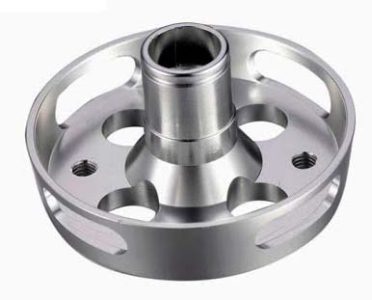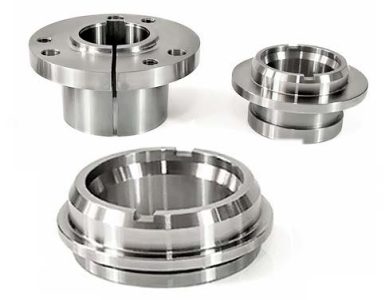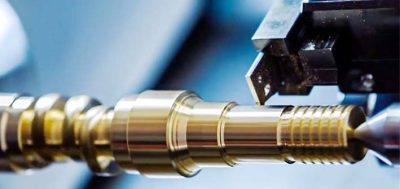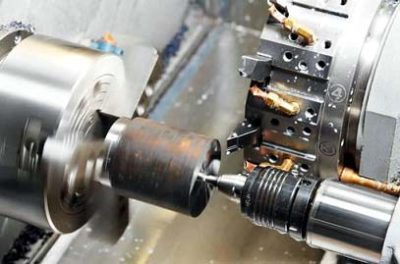catégories de produits
Mots clés du produit
Technique pour les pièces de traitement de tour CNC
Qu'est-ce que le traitement au tour?
C'est, sur le tour, la forme et la taille de l'ébauche sont modifiées par le mouvement de rotation de la pièce et le mouvement linéaire ou courbe de l'outil, et traité pour répondre aux exigences des pièces de dessin.
Qu'est-ce que le traitement au tour?
C'est, sur le tour, la forme et la taille de l'ébauche sont modifiées par le mouvement de rotation de la pièce et le mouvement linéaire ou courbe de l'outil, et traité pour répondre aux exigences des pièces de dessin.
Turning is a method of cutting the workpiece by using the rotation of the part relative to the tool on the lathe. The cutting function of turning is mainly provided by the workpiece rather than the tool. Turning is the most basic and common cutting method, and it occupies a very important position in production. Turning is suitable for machining revolving surfaces, and most workpieces with revolving surfaces can be processed by turning methods. Such as inner and outer cylindrical surface, inner and outer conical surface, end surface, groove, thread and rotary forming surface, etc., the tools used are mainly turning tools.
Among all kinds of metal cutting machine tools, lathes are the most widely used, accounting for about 50% du nombre total de machines-outils. The lathe can not only use turning tools to turn the workpiece, but also use drills, reamers, taps and knurling tools for drilling, alésage, tapping and knurling operations. According to different process characteristics, layout forms and structural characteristics, lathes can be divided into: Horizontal lathes, floor lathes, vertical lathes, turret lathes and profiling lathes, etc., most of which are horizontal lathes.
CNC lathe processing can process various types of materials. There are: 316, 304 acier inoxydable, Acier Carbone, tool steel, acier allié, alliage d'aluminium, alliage de magnésium, alliage de zinc, alliage de titane, cuivre, fer, Plastique, acrylique, POM, UHWM et autres matières premières. It can process parts with complex structures.
Precautions for CNC lathe processing
La technologie de traitement du tour CNC est similaire à celle du tour ordinaire. Cependant, parce que le tour CNC est un serrage unique, traitement continu et automatique pour compléter tous les processus de tournage. Donc, les aspects suivants doivent être pris en compte:
1. Choix raisonnable de la quantité de coupe:
For high-efficiency metal cutting processing, the processed material, outils de coupe, and cutting conditions are the three major elements. These determine the processing time, tool life and processing quality. The economical and effective machining method must be the reasonable choice of cutting conditions.
Three elements of cutting conditions: Cutting speed, feed rate and depth of cut directly cause tool damage. With the increase of cutting speed, the temperature of the tool tip will rise, which will cause mechanical, chemical and thermal wear. Cutting speed increased by 20%, tool life will be reduced by 1/2. The relationship between the feed condition and the wear on the back of the tool occurs in a very small range. Cependant, the feed rate is large, la température de coupe augmente, and the tool wear is large. It has less influence on the tool than cutting speed. While the impact of the cutting depth of the tool is not as cutting speed and feed large. Cependant, when cutting at a small depth of cut, the material being cut produces a hardened layer, which will also affect the life of the tool.
The user should choose the cutting speed to be used according to the processed material, dureté, cutting state, material type, feed rate, and depth of cut. The most suitable processing conditions are selected on the basis of these factors. Regular, stable wear and longevity are the ideal conditions. Cependant, in actual operations, the choice of tool life is related to tool wear, dimensional changes to be processed, Qualité de surface, cutting noise, and processing heat. When determining the processing conditions, it is necessary to conduct research according to the actual situation. For difficult-to-machine materials such as stainless steel, heat-resistant alloys, titanium alloys, and magnesium alloys, coolants or turning blades with good rigidity can be used.
2. Choose a tool reasonably:
(1) When rough turning, choose a tool with high strength and good durability to meet the requirements of large turning depth and large feed when rough turning.
(2) En finissant de tourner, choose tools with high precision and good durability. To ensure the requirements of machining accuracy.
(3) In order to reduce the time of tool change and facilitate tool setting, machine clamp tools and machine clamp turning blades should be used as much as possible.
3. Reasonable selection of fixtures:
(1) Try to use general fixtures to clamp the workpiece and avoid using special fixtures;
(2) The positioning datums of the parts coincide to reduce positioning errors.
4. Determine the processing route: The processing route is the movement track and direction of the tool relative to the part during the processing of the index-controlled machine tool.
(1) It should be able to guarantee the processing accuracy and surface roughness requirements;
(2) The processing route should be shortened as much as possible to reduce the tool idle travel time.

machine cnc tournant l'aluminium

machine tool processing machinery parts

turning brass auto parts manufacturing

Clamping for lathe machining
5. The relationship between processing route and machining allowance:
Under the condition that the CNC lathe has not reached the popular use, the excess margin on the blank, especially the margin containing the forging and casting hard skin layer, should be arranged on the ordinary lathe for processing. If you must use a CNC lathe for processing, you need to pay attention to the flexible arrangement of the program.
6. Main points of fixture installation:
The connection between the hydraulic chuck and the hydraulic clamping cylinder is realized by a tie rod. The main points of hydraulic chuck clamping are as follows:
D'abord, remove the nut on the hydraulic cylinder with a moving hand, remove the pull tube, and pull it out from the back of the spindle. Then use the moving hand to remove the chuck fixing screw to remove the chuck.
Contactez-nous
En attente de votre email, nous vous répondrons dans les 12 heures avec des informations précieuses dont vous aviez besoin.
 English
English العربية
العربية 中文(漢字)
中文(漢字) Čeština
Čeština Dansk
Dansk Nederlands
Nederlands Suomi
Suomi Français
Français Deutsch
Deutsch Italiano
Italiano 日本語
日本語 ಕನ್ನಡ
ಕನ್ನಡ 한국어
한국어 Português
Português Русский
Русский Slovenčina
Slovenčina Español
Español Svenska
Svenska Türkçe
Türkçe





